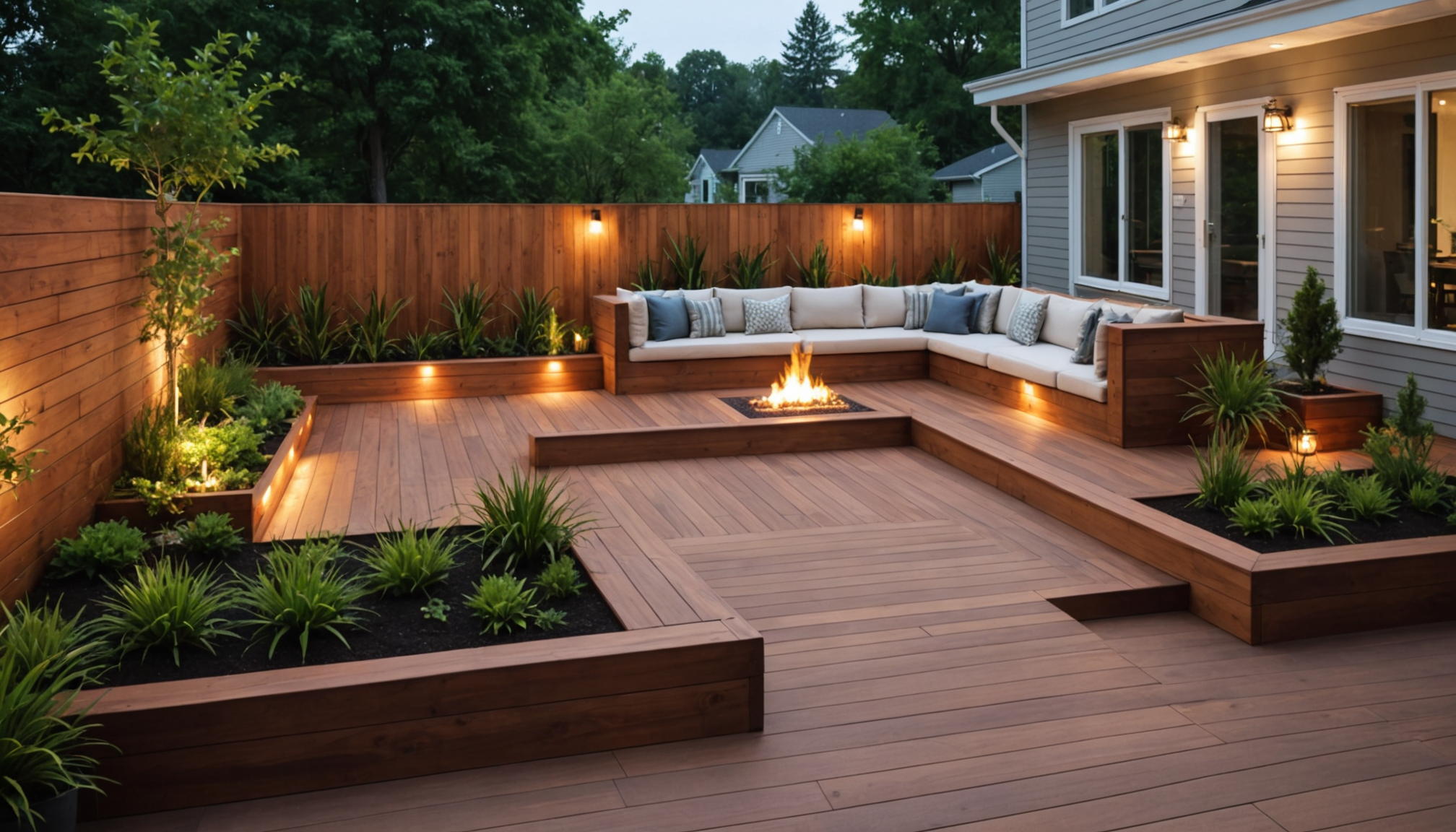When embarking on a DIY deck build, one of the most crucial initial steps is planning your deck design. This not only influences the deck’s appearance but also affects its functionality and longevity. An effectively crafted design serves as the foundation for your entire project, ensuring that all subsequent stages progress smoothly and more efficiently.
Begin by evaluating the primary purpose of your deck. Consider whether it will serve as an entertainment space for hosting gatherings, a quiet retreat for relaxation, or perhaps a versatile area combining multiple functions. Establishing a clear purpose will guide your decisions on size, layout, and features, such as built-in seating or planters.
The next step involves assessing the available space in your yard. Accurate measurements of your proposed deck area are paramount. Take into consideration existing features like trees, fences, or other landscaping elements, as they can both challenge and enhance your design. Ensure the size of your deck offers a functional flow, allowing for movement and ease of use.
Think about the style you envision for your deck. It should complement the existing architecture of your home to ensure aesthetic cohesion. Whether it’s a rustic wooden finish in harmony with a country-style house or a modern composite material fitting a contemporary design, aligning your deck’s style with your home will elevate the overall appeal.
Consider how the orientation of your deck will impact both its practicality and comfort. For instance, a south-facing deck may provide ample sunlight for gatherings but might require shading solutions for hotter months. Conversely, a north-facing deck could excel as a cool escape but might need heaters or windbreaks in cooler climates.
Lighting solutions are another essential component of deck design. Adequate lighting can extend the usability of your space into the nighttime, enhancing both safety and ambiance. Evaluate options from classic string lights and solar-powered fixtures to in-ground lighting that defines walkways.
A successful design should also integrate considerations for privacy. Determine whether you will need fences, railings, or lush plantings to create a secluded haven from neighbors or street view. These elements can significantly influence comfort and enjoyment in your outdoor space.
For help visualizing your plans, you might want to use design software or consult with professionals who can provide insights on spatial dynamics and aesthetic details. Consider this initial investment as a form of insurance against costly mistakes further down the line.
To succinctly compare and contrast potential materials and their suitability for different design considerations, see the table below:
| Material | Durability | Maintenance | Cost | Aesthetics |
| Wood | Moderate | High | Medium | Warm, Natural |
| Composite | High | Low | High | Modern, Clean |
| Aluminum | High | Low | High | Industrial, Sleek |
| Concrete | High | Low to Moderate | Medium | Versatile, Sturdy |
Once you’ve solidified your deck’s design, you’re better positioned to proceed to the next stage of your project with clarity and confidence. This foundational planning step is crucial for turning your deck vision into a successful reality.
selecting the right materials
When it comes to building your DIY deck, choosing the right materials is pivotal to the project’s success. The materials you select will impact not only the deck’s aesthetic and functionality but also its durability and maintenance requirements. Follow these steps to ensure you make the best material choices for your deck:
- Assess your Climate: Different materials perform better in varied weather conditions. For instance, if you live in an area with high humidity or frequent rainfall, composite materials might be a better choice as they resist warping and rotting. In contrast, dry climates might be more forgiving for untreated woods.
- Consider Usage and Traffic: Think about how much foot traffic your deck will endure. Heavy usage areas benefit from robust materials like composite or aluminum. Meanwhile, less trafficked or smaller decks might do well with pressure-treated wood options.
- Evaluate Aesthetic Preferences: Your deck should complement your home’s exterior style. If a natural look is desired, wood varieties like cedar or redwood can offer beautiful results. For a sleek, modern appeal, composites or aluminum might be more suitable.
- Understand Maintenance Levels: Wood decks, while beautiful, require regular maintenance, including sealing and staining. Composite, aluminum, and some coated wood options are more low-effort, requiring only periodic cleaning to maintain their look.
- Factor in Sustainability: Many environmentally conscious homeowners are interested in sustainable materials. Look for FSC-certified woods or composite products made from recycled plastics to minimize your environmental footprint.
- Budget Accordingly: Analyze your overall budget and balance it with your material preference. While composite and aluminum options present higher upfront costs, their longevity and reduced maintenance cost could offer savings over time. Pressure-treated wood is often less expensive but might incur more in maintenance costs over the years.
- Consider Availability: Check local suppliers for availability and delivery options of your preferred materials. Rare or imported materials can incur higher transport costs and longer wait times.
- Conduct a Test: If uncertain, purchase a small quantity of each of your top material choices and conduct tests by leaving them outdoors for a few weeks to observe color change, feel or any weather-related impacts.
Armed with this information, you’ll be more equipped to choose a material that aligns with your specific needs and preferences, helping ensure your new deck is both beautiful and functional for years to come. Remember that time spent evaluating your options now will pay off with a longer-lasting and more attractive outdoor space.
understanding local building codes
Navigating the intricacies of local building codes is a pivotal component of any successful DIY deck project. These codes are put in place to ensure safety, structural integrity, and environmental compliance. By taking the time to comprehend and adhere to these regulations, you not only avoid potential fines and legal issues but also ensure your deck is safe and durable.
Research and Compliance: Begin the process by researching the specific building codes and permitting requirements in your area. These regulations can vary significantly from one region to another, including specific guidelines around deck height, load capacity, railing requirements, and more. It’s essential to identify whether a building permit or a plan approval is necessary for your project. Consulting your local building authority or a professional contractor can provide clarity and ensure you’re starting off on the right foot.
Soil and Site Considerations: Understanding local codes means not just looking at the deck itself, but also the ground it stands on. Certain codes may dictate the types of foundations or footings necessary depending on soil type or load-bearing capacity. This could involve mandated depths for posts or specifications for concrete footers. Adhering to these requirements is crucial for the long-term stability of your deck, particularly in areas with volatile weather or seismic activity.
Safety Features: Building codes often include detailed safety features that need to be incorporated into your deck design. This typically involves specifications for railings, stairs, and potentially even lighting. For example, codes may require railings to be a certain height or stair risers to meet specific dimensions. By ensuring these elements meet local standards, you contribute to the safety of all who use the deck, preventing falls and injuries.
Environmental and Aesthetic Regulations: In addition to safety and structural codes, there may also be environmental considerations, such as allowances for water runoff or preserving green space. Aesthetic guidelines might also come into play, especially if your property is situated in a historically preserved area or a community with strict homeowner association rules.
The Benefits of Professional Input: Even with due diligence, navigating building codes can be complex. Seeking professional input from a licensed contractor or architect can be worthwhile. Their expertise allows them to quickly interpret and apply local building codes, saving you time and reducing the risk of non-compliance issues down the line. Moreover, having detailed, professional plans may streamline the permitting process with local authorities.
Taking the time to thoroughly understand and integrate local building codes into your deck design elevates your project from a simple home improvement task to a well-considered architectural enhancement. It protects not only the structural integrity of your deck but also the safety of its users, while potentially enhancing your property’s value. Keeping these codes in mind will help you create a space that is not just enjoyable but also legally compliant and neighborhood-friendly.
tools and equipment essentials
Embarking on a deck-building project without the right tools and equipment is akin to setting off on a journey without a map. The proper gear is essential to turning your deck design into a well-constructed reality. Equipping yourself with the necessary tools ensures the building process is smoother, more efficient, and precise.
Firstly, acquire a solid set of foundational tools. This includes a high-quality tape measure, crucial for accurate assessment and alignment during the construction process. Ensure your toolbox contains a speed square for marking straight lines and angles, a spirit level for checking elevations and flatness, and a reliable chalk line for layout work. These tools are indispensable for maintaining precision throughout your build.
A powerful drill goes a long way in reducing manual labor significantly, so investing in one with multiple speed settings and a wide array of bits is highly recommended. It should be complemented with an impact driver to make driving screws into tough materials easier. To cut materials to size, a circular saw with adjustable cutting depths is a must-have, enabling you to swiftly make both straight and angled cuts. For more intricate cuts, consider including a jigsaw in your arsenal.
Safety cannot be overlooked, and personal protective equipment (PPE) is critical. Ensure you have goggles to shield your eyes from debris, sturdy gloves to protect your hands, ear protection to guard against noise, and a dust mask to prevent inhalation of sawdust and other particulates. A hard hat is also advisable if you’ll be working with heavy or suspended materials, especially when constructing elevated areas.
For fastening, stock up on various nails, screws, and joist hangers. Depending on your design, you may need additional hardware like bolts or structural connectors, so plan accordingly. A pneumatic nail gun can speed up the process significantly, and a power screwdriver will help in securely fastening deck boards without tiring yourself out.
Lastly, don’t underestimate the value of having a high-quality plan or blueprint. This not only serves as a visual guide but also ensures your adherence to design and building codes—helping you stay organized and on track with the project timeline.
By gathering these essential tools and equipment, you set the stage for a DIY deck build that balances efficiency with precision. The right equipment ensures that each bolt is securely fastened, every cut is true to measure, and every piece aligns to create a deck that is not only aesthetically pleasing but structurally sound. When you’re well-prepared, the building process becomes not just an exercise in labor, but a creative and fulfilling endeavor that transforms your outdoor space into something truly special.
step-by-step building guide
After gathering the necessary tools, it’s time to break down the building process into clear, manageable steps to ensure a successful DIY deck build. Kick off the project by preparing the site. This involves clearing the area of debris and any obstructions, ensuring the ground is level, and marking out the specific dimensions of your deck using wooden stakes and string lines to maintain alignment.
Once the site is prepped, move to setting the foundation by installing the footings. Dig holes following the depth and width as dictated by local building codes—these often require footings to extend below the frost line to prevent shifting. Depending on your design, you may need concrete footings. Use a post hole digger to create uniform holes and fill with concrete mix, ensuring the surface is levelled before it sets.
With your footings ready, proceed to construct the framework, starting with the ledger board by firmly attaching it to your house. This anchor point supports a significant portion of your deck’s weight, so it’s critical it is securely fastened. Ensure any flashing is installed to protect against weather damage. Next, lay out the outer beams, using bolts or screws for sturdy connections. Cross-check with your plans frequently to ensure everything aligns correctly.
Once the perimeter is defined, continue with the installation of joists. Space them evenly and secure them within joist hangers attached to the ledger board and beams. These will form the structural skeleton onto which the decking boards will be laid. Use a carpenter’s square and a level to check that everything remains perpendicular and even.
With the frame in place, the next step is to lay the decking boards. Decide on the board pattern that complements your design style before starting. Secure them using the appropriate screws or hidden fasteners, maintaining a small gap between each board for drainage and expansion. This meticulous attention to pattern and spacing creates a professional and polished finish.
Focus then shifts to the railing system where existing regulations outline the height and design requirements, crucial for safety. Measure and secure railing posts, ensuring they are to code, then attach the top and bottom rails, followed by balusters or panel sections.
Finish your deck with stairs if your design incorporates them, making sure they align with local codes concerning rise and run. Securely attach each step and use appropriate treads and risers to ensure safety and durability.
Finally, apply sealants or stains to protect the wood from weathering and enhance its aesthetic appeal, or clean and maintain composite or other non-organic materials as per manufacturer recommendations. This offers both a protective layer and a polished look, setting the tone for your outdoor gatherings.
Taking the time to follow this structured approach not only results in a durable piece but also turns the complex task of deck building into a fulfilling experience.


